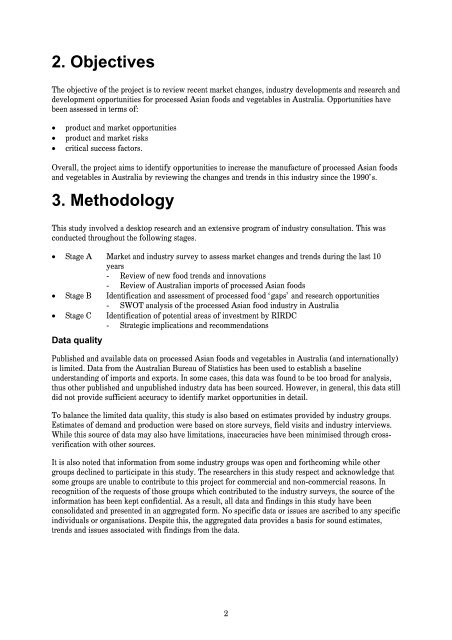Processed Asian Foods in Australia – An update
Processed Asian Foods in Australia – An update
Processed Asian Foods in Australia – An update
Create successful ePaper yourself
Turn your PDF publications into a flip-book with our unique Google optimized e-Paper software.
2. Objectives<br />
The objective of the project is to review recent market changes, <strong>in</strong>dustry developments and research and<br />
development opportunities for processed <strong>Asian</strong> foods and vegetables <strong>in</strong> <strong>Australia</strong>. Opportunities have<br />
been assessed <strong>in</strong> terms of:<br />
• product and market opportunities<br />
• product and market risks<br />
• critical success factors.<br />
Overall, the project aims to identify opportunities to <strong>in</strong>crease the manufacture of processed <strong>Asian</strong> foods<br />
and vegetables <strong>in</strong> <strong>Australia</strong> by review<strong>in</strong>g the changes and trends <strong>in</strong> this <strong>in</strong>dustry s<strong>in</strong>ce the 1990’s.<br />
3. Methodology<br />
This study <strong>in</strong>volved a desktop research and an extensive program of <strong>in</strong>dustry consultation. This was<br />
conducted throughout the follow<strong>in</strong>g stages.<br />
• Stage A Market and <strong>in</strong>dustry survey to assess market changes and trends dur<strong>in</strong>g the last 10<br />
years<br />
- Review of new food trends and <strong>in</strong>novations<br />
- Review of <strong>Australia</strong>n imports of processed <strong>Asian</strong> foods<br />
• Stage B Identification and assessment of processed food ‘gaps’ and research opportunities<br />
- SWOT analysis of the processed <strong>Asian</strong> food <strong>in</strong>dustry <strong>in</strong> <strong>Australia</strong><br />
• Stage C Identification of potential areas of <strong>in</strong>vestment by RIRDC<br />
- Strategic implications and recommendations<br />
Data quality<br />
Published and available data on processed <strong>Asian</strong> foods and vegetables <strong>in</strong> <strong>Australia</strong> (and <strong>in</strong>ternationally)<br />
is limited. Data from the <strong>Australia</strong>n Bureau of Statistics has been used to establish a basel<strong>in</strong>e<br />
understand<strong>in</strong>g of imports and exports. In some cases, this data was found to be too broad for analysis,<br />
thus other published and unpublished <strong>in</strong>dustry data has been sourced. However, <strong>in</strong> general, this data still<br />
did not provide sufficient accuracy to identify market opportunities <strong>in</strong> detail.<br />
To balance the limited data quality, this study is also based on estimates provided by <strong>in</strong>dustry groups.<br />
Estimates of demand and production were based on store surveys, field visits and <strong>in</strong>dustry <strong>in</strong>terviews.<br />
While this source of data may also have limitations, <strong>in</strong>accuracies have been m<strong>in</strong>imised through crossverification<br />
with other sources.<br />
It is also noted that <strong>in</strong>formation from some <strong>in</strong>dustry groups was open and forthcom<strong>in</strong>g while other<br />
groups decl<strong>in</strong>ed to participate <strong>in</strong> this study. The researchers <strong>in</strong> this study respect and acknowledge that<br />
some groups are unable to contribute to this project for commercial and non-commercial reasons. In<br />
recognition of the requests of those groups which contributed to the <strong>in</strong>dustry surveys, the source of the<br />
<strong>in</strong>formation has been kept confidential. As a result, all data and f<strong>in</strong>d<strong>in</strong>gs <strong>in</strong> this study have been<br />
consolidated and presented <strong>in</strong> an aggregated form. No specific data or issues are ascribed to any specific<br />
<strong>in</strong>dividuals or organisations. Despite this, the aggregated data provides a basis for sound estimates,<br />
trends and issues associated with f<strong>in</strong>d<strong>in</strong>gs from the data.<br />
2

















